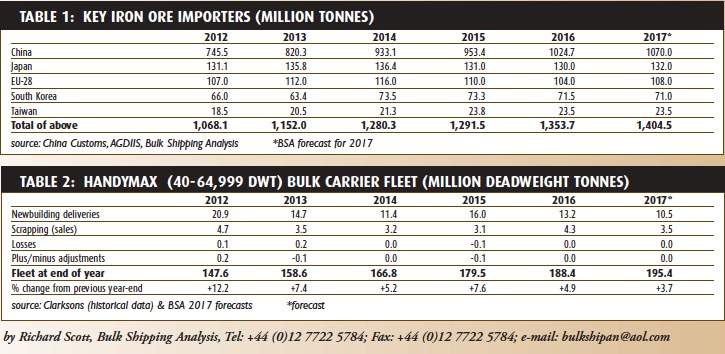by Richard Scott, Bulk Shipping Analysis
Signs of extra support for commodity imports into
countries around the world have become more
prominent during the past few months. Growth in
global seaborne dry bulk trade has benefited. But there are
still doubts about whether this improved pace can be
sustained during the remainder of 2017.
A moderately encouraging background is provided by
recent economic indicators. In the USA, European Union and
Japan statistics point to more positive trends, implying
stronger manufacturing and construction activity. In China,
although the economy still appears to be well supported,
rapidly growing debts reflected in policies designed to curb
lending may adversely affect economic growth over the
period ahead.
IRON ORE
Steel production started this year briskly in the main raw
materials importing countries. World Steel Association
figures show that China’s crude steel production in the first
four months of 2017 was 4.6% above the volume seen in
last year’s same period, at 274mt (million tonnes). EU
output was 4.5% higher at 57mt, while South Korea’s total
was up by 2.8% at 23mt. Japan achieved a 1.9% increase to
35mt.
While these rises imply additional imports of iron ore
(shown in table 1) and coking coal, other factors can alter
the relationship. Attention immediately focuses on China,
the dominant ore importer. Further substitution of domestic
iron ore supplies from Chinese mines with imports continues,
but some of the large expansion of imports in recent months
has been stored at ports. If these greatly expanded stockpiles
are drawn down, import demand could be weakened.
COAL
Some forecasters are more confident about an increase in
global seaborne coal trade in 2017 after decreases in the
past two years. However, negative influences affecting
import demand in many countries remain clearly visible.
These are likely to persist in the longer term, given the
worldwide strategy of switching towards cleaner fuels and
renewable energy.
A large part of this year’s expected growth in the global
trade total is likely to reflect higher volumes into China.
Already there has been a big rise. China’s coal imports during
the first four months of 2017 were 22mt or one-third above
the same period of last year, reaching over 89mt. Both steel
production and thermal power generation expanded, and
additional domestic coal output only slightly restrained imports.
GRAIN
Global trade in wheat and coarse grains in the 2016/17 crop
year ending this month looks set to edge upwards by 1%,
reaching 349mt, according to the International Grains
Council’s latest estimates. Tentative calculations for the new
2017/18 year starting July suggest little change, just a small
decrease to 347mt.
What clues about trade over the next twelve months have
emerged? One indication is summer domestic grain harvests
in northern hemisphere importing countries. Changes in
these often affect foreign purchases. Currently there are
more signs of higher production than lower output, but
weather conditions over the weeks ahead will determine the
results. Importers expected to achieve greatly improved
harvests include France, India and Morocco.
MINOR BULKS
Forest products trade provides many bulk as well as non-bulk
cargoes, including logs, sawnwoods, woodchips and pulp and
other items. It is one of the largest ‘minor’ bulk categories,
with global seaborne movements probably exceeding 350mt
last year. Further growth could be aided by reviving
construction and manufacturing activity in some importing
countries.
BULK CARRIER FLEET
Among bulk carrier size groups, the Handymax 40–64,999dwt
group is still growing briskly (see table 2), possibly
increasing by 4% in 2017. Newbuilding deliveries are likely
to decline this year, but scrapping of older vessels probably
will be reduced also. Most of the new ships being delivered
are in the ‘Ultramax’ sub-group (capacity exceeding 60,000
deadweight), a popular choice when ordered a few years ago.
